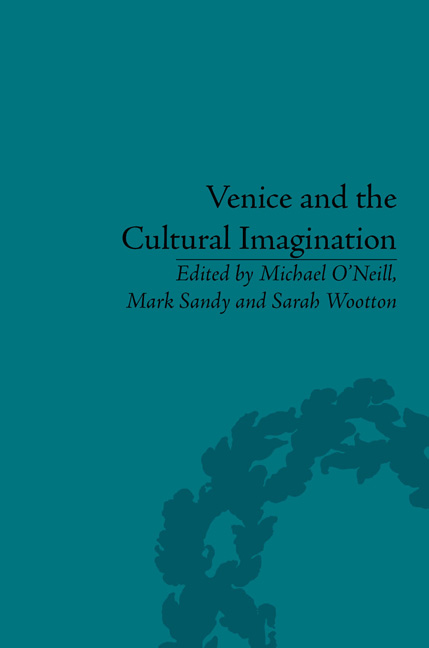Book contents
- Frontmatter
- CONTENTS
- Acknowledgements
- List of Figures
- Notes on Contributors
- Introduction
- 1 A ‘More Beloved Existence’: From Shakespeare's ‘Venice’ to Byron's Venice
- 2 Reimagining Venice and Visions of Decay in Wordsworth, the Shelleys and Thomas Mann
- 3 J. M. W. Turner and the ‘Floating City’
- 4 Venice and Opera: Tradition, Propaganda and Transformation
- 5 Venice, Dickens, Robert Browning and the Victorian Imagination
- 6 ‘The Lamp of Memory’: Ruskin and Venice
- 7 Edith Wharton's ‘Venetian Backgrounds’
- 8 Henry James's Venice and the Visual Arts
- 9 The Myth of Venice in the Decline of Eliot and Pound
- 10 Representations of Venice in Daphne du Maurier's Don't Look Now and Nicolas Roeg's Screen Adaptation
- Notes
- Select Bibliography
- Index
Introduction
- Frontmatter
- CONTENTS
- Acknowledgements
- List of Figures
- Notes on Contributors
- Introduction
- 1 A ‘More Beloved Existence’: From Shakespeare's ‘Venice’ to Byron's Venice
- 2 Reimagining Venice and Visions of Decay in Wordsworth, the Shelleys and Thomas Mann
- 3 J. M. W. Turner and the ‘Floating City’
- 4 Venice and Opera: Tradition, Propaganda and Transformation
- 5 Venice, Dickens, Robert Browning and the Victorian Imagination
- 6 ‘The Lamp of Memory’: Ruskin and Venice
- 7 Edith Wharton's ‘Venetian Backgrounds’
- 8 Henry James's Venice and the Visual Arts
- 9 The Myth of Venice in the Decline of Eliot and Pound
- 10 Representations of Venice in Daphne du Maurier's Don't Look Now and Nicolas Roeg's Screen Adaptation
- Notes
- Select Bibliography
- Index
Summary
Lately I stood at the bridge
In the brown night.
From afar there came a song:
a golden drop, it swelled
across the trembling surface.
Gondolas, lights, music –
drunken it swam out into the gloom…
My soul a stringed instrument,
Touched by invisible hands…
(Friedrich Nietzsche)But what we want art to do for us is to stay what is fleeting, and to enlighten what is incomprehensible, to incorporate the things that have no measure, and immortalize the things that have no duration.
(John Ruskin)I
We begin with two responses to Venice, each immediately revealing the fact that the city mirrors the mind of the visitor. If the place confirms Nietzsche in his radical subjectivity, his ‘soul a stringed instrument’, it reminds Ruskin of his relationship with ‘things’, not merely the stones he measured whilst clambering up ladders, but also the ‘things that have no measure’. Venice is at once place and dream, substance and shadow. Nietzsche's lines gesture, in quasi-Byronic mode, from the solidity of the Rialto towards a city which shimmers as much as it abides, a ‘golden drop’ of delicate music, simultaneously intensified and quenched by its own surrounding ‘gloom’. Ruskin, alert to the ‘fleeting’, finds in the city a spur to his and our desire that art should ‘stay’ what is seemingly ephemeral.
- Type
- Chapter
- Information
- Venice and the Cultural Imagination'This Strange Dream upon the Water', pp. 1 - 10Publisher: Pickering & ChattoFirst published in: 2014



